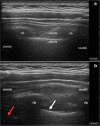The ultrasound-guided proximal intercostal block: anatomical study and clinical correlation to analgesia for breast surgery
- PMID: 31164083
- PMCID: PMC6549312
- DOI: 10.1186/s12871-019-0762-2
The ultrasound-guided proximal intercostal block: anatomical study and clinical correlation to analgesia for breast surgery
Abstract
Background: The ultrasound-guided proximal intercostal block (PICB) is performed at the proximal intercostal space (ICS) between the internal intercostal membrane (IIM) and the endothoracic fascia/parietal pleura (EFPP) complex. Injectate spread may follow several routes and allow for multilevel trunk analgesia. The goal of this study was to examine the anatomical spread of large-volume PICB injections and its relevance to breast surgery analgesia.
Methods: Fifteen two-level PICBs were performed in ten soft-embalmed cadavers. Radiographic contrast mixed with methylene blue was injected at the 2nd(15 ml) and 4th(25 ml) ICS, respectively. Fluoroscopy and dissection were performed to examine the injectate spread. Additionally, the medical records of 12 patients who had PICB for breast surgery were reviewed for documented dermatomal levels of clinical hypoesthesia. The records of twelve matched patients who had the same operations without PICB were reviewed to compare analgesia and opioid consumption.
Results: Median contrast/dye spread was 4 (2-8) and 3 (2-5) vertebral segments by fluoroscopy and dissection respectively. Dissection revealed injectate spread to the adjacent paravertebral space, T3 (60%) and T5 (27%), and cranio-caudal spread along the endothoracic fascia (80%). Clinically, the median documented area of hypoesthesia was 5 (4-7) dermatomes with 100 and 92% of the injections covering adjacent T3 and T5 dermatomes, respectively. The patients with PICB had significantly lower perioperative opioid consumption and trend towards lower pain scores.
Conclusions: In this anatomical study, PICB at the 2nd and 4th ICS produced lateral spread along the corresponding intercostal space, medial spread to the adjacent paravertebral/epidural space and cranio-caudal spread along the endothoracic fascial plane. Clinically, combined PICBs at the same levels resulted in consistent segmental chest wall analgesia and reduction in perioperative opioid consumption after breast surgery. The incomplete overlap between paravertebral spread in the anatomical study and area of hypoesthesia in our clinical findings, suggests that additional non-paravertebral routes of injectate distribution, such as the endothoracic fascial plane, may play important clinical role in the multi-level coverage provided by this block technique.
Keywords: Breast surgery; Intercostal block; Intercostal space; Nerve block; Paravertebral space.
Conflict of interest statement
The authors declare that they have no competing interests.
Figures







Similar articles
-
A prospective, randomized comparison of ultrasonographic visualization of proximal intercostal block vs paravertebral block.BMC Anesthesiol. 2020 Jan 9;20(1):13. doi: 10.1186/s12871-020-0929-x. BMC Anesthesiol. 2020. PMID: 31918668 Free PMC article. Clinical Trial.
-
Ultrasound-guided proximal intercostal block for cervicothoracic sympathetic blockade: a proof-of-concept cadaveric study.Reg Anesth Pain Med. 2025 May 22:rapm-2025-106546. doi: 10.1136/rapm-2025-106546. Online ahead of print. Reg Anesth Pain Med. 2025. PMID: 40404192
-
Is a Retrolaminar Approach to the Thoracic Paravertebral Space Possible?: A Human Cadaveric Study.Reg Anesth Pain Med. 2018 Nov;43(8):864-868. doi: 10.1097/AAP.0000000000000828. Reg Anesth Pain Med. 2018. PMID: 29923954
-
Anatomical insights into injectate spread after thoracic erector spinae plane block: A systematic review.J Clin Anesth. 2023 Oct 28;92:111304. doi: 10.1016/j.jclinane.2023.111304. Online ahead of print. J Clin Anesth. 2023. PMID: 39491273 Review.
-
Assessment of Intercostal Nerve Block Analgesia for Thoracic Surgery: A Systematic Review and Meta-analysis.JAMA Netw Open. 2021 Nov 1;4(11):e2133394. doi: 10.1001/jamanetworkopen.2021.33394. JAMA Netw Open. 2021. PMID: 34779845 Free PMC article.
Cited by
-
Persistent Post-Mastectomy Pain: The Impact of Regional Anesthesia Among Patients with High vs Low Baseline Catastrophizing.Pain Med. 2021 Aug 6;22(8):1767-1775. doi: 10.1093/pm/pnab039. Pain Med. 2021. PMID: 33560352 Free PMC article.
-
A prospective, randomized comparison of ultrasonographic visualization of proximal intercostal block vs paravertebral block.BMC Anesthesiol. 2020 Jan 9;20(1):13. doi: 10.1186/s12871-020-0929-x. BMC Anesthesiol. 2020. PMID: 31918668 Free PMC article. Clinical Trial.
-
Efficacy of modified thoracoabdominal nerve block through perichondrial approach following laparoscopic inguinal hernia repair surgery: a randomized controlled trial.Braz J Anesthesiol. 2023 Sep-Oct;73(5):595-602. doi: 10.1016/j.bjane.2023.05.001. Epub 2023 May 16. Braz J Anesthesiol. 2023. PMID: 37201747 Free PMC article. Clinical Trial.
-
Ultrasound-guided modified thoracoabdominal nerve block for postoperative analgesia in laparoscopic renal cyst decompression: a randomized double-blind controlled trial.Front Med (Lausanne). 2025 Jul 4;12:1582428. doi: 10.3389/fmed.2025.1582428. eCollection 2025. Front Med (Lausanne). 2025. PMID: 40687720 Free PMC article.
-
Modified thoracoabdominal nerve block through perichondrial approach (M-TAPA) vs local infiltration for pain management after laparoscopic cholecystectomy surgery: a randomized study.J Anesth. 2023 Apr;37(2):254-260. doi: 10.1007/s00540-022-03158-0. Epub 2022 Dec 28. J Anesth. 2023. PMID: 36575362 Clinical Trial.
References
Publication types
MeSH terms
LinkOut - more resources
Full Text Sources

